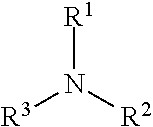Gasoline fuel composition for improved performance in fuel injected engines
a technology of gasoline fuel and composition, which is applied in the direction of fuels, organic chemistry, liquid carbonaceous fuels, etc., can solve the problems that the mannich dispersant used in port fuel injected gasoline engines cannot provide suitable improvement in direct injected gasoline engines, and the dispersant that was previously used for gasoline engines cannot be effective for cleaning up direct fuel injected engines. the effect of improving engine performance, reducing the amount of deposits, and improving the cleanliness of the injector
- Summary
- Abstract
- Description
- Claims
- Application Information
AI Technical Summary
Benefits of technology
Problems solved by technology
Method used
Image
Examples
##ventive example 1
Inventive Example 1
[0079]A mixture of oleylamido propyl dimethylamine (150 g), 1,2-epoxy butane (59 g), acetic acid (37 g), and methanol (50 g) was heated slowly to 70° C. under an inert atmosphere. The mixture was gently refluxed at 70° C. for 2.5 hour. Volatiles were removed under reduced pressure to give the desired product as a brownish oil having a chlorine content that is undetectable.
##ventive example 2
Inventive Example 2
[0080]A mixture of oleylamido propyl dimethylamine (232 g), 1,2-epoxy butane (91 g), 2-ethylhexanoic acid (136 g), and methanol (93 g) was heated slowly to 70° C. under inert atmosphere. The mixture was gently refluxed at 70° C. for 1 hour, then 75° C. for 2 hours. Volatiles were removed under reduced pressure to give the desired product as a brownish oil.
##ventive example 3
Inventive Example 3
[0081]A quaternary ammonium salt was prepared similarly to that of Inventive Example 1 except that propylene oxide was used in place of 1,2-epoxy butane, and oleic acid was used in place of acetic acid. The reaction was carried out at about 50° C. in a pressured vessel. The resulting product was a brownish viscose oil.
PUM
| Property | Measurement | Unit |
|---|---|---|
| temperature | aaaaa | aaaaa |
| temperature | aaaaa | aaaaa |
| total weight | aaaaa | aaaaa |
Abstract
Description
Claims
Application Information
 Login to View More
Login to View More - R&D
- Intellectual Property
- Life Sciences
- Materials
- Tech Scout
- Unparalleled Data Quality
- Higher Quality Content
- 60% Fewer Hallucinations
Browse by: Latest US Patents, China's latest patents, Technical Efficacy Thesaurus, Application Domain, Technology Topic, Popular Technical Reports.
© 2025 PatSnap. All rights reserved.Legal|Privacy policy|Modern Slavery Act Transparency Statement|Sitemap|About US| Contact US: help@patsnap.com



